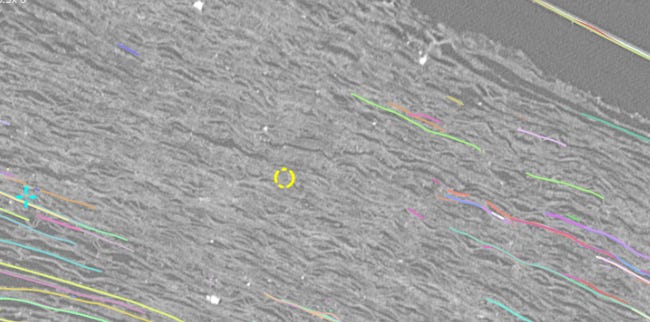New Prizes and an Update on Progress
This year, we’re issuing more frequent, targeted awards that address specific technical challenges.
We’re also going to offer targeted “asks” for prizes, as we become aware of what roadblocks lie in the way. We still encourage open ended solutions to problems, but will often provide more specific requirements for some progress prizes. For more detailed information and submission requirements, check out the prizes page of our site.
Read an Entire Scroll Prize ($200,000)
We’ve relaxed the ink detection requirements on this one a bit from our previous year’s prize, as the spirit of this prize is achieving accurate automatic segmentation.
Ink remains a part of the criteria primarily due to its use as an instant sanity and quality check for segmentation quality in ways that other metrics simply cannot replace.
Looking at the image below (left), it’s immediately apparent where segmentation quality is good — we’ve got well delineated columns, and nice continuous rows with even spacing and good alignment. The image on the right, although in places is accurate, is clearly not the same level of quality.
We’re very much open to partial awards for this prize, so if your segmentation seems good, but your ink detection doesn’t quite meet the mark in terms of readability, please do not hesitate to submit! Multiple submissions are allowed (encouraged, even).


First Letters and First Title Prizes ($60,000)
We’re continuing with our first letters and first title prizes — we have yet to find letters in P.Herc. Paris 3 (Scroll 2), P.Herc. 0332 (Scroll 3) , and P.Herc. 1667 (Scroll 4), and we’ve yet to locate a title in any of our scans. We’ve released a ton of new segmentations within Scroll 3, Scroll 4, and Scroll 5 to help facilitate this effort.
This Scroll 5 trace, for example, begins about 2 wraps past the fold (just past the umbilicus) and extends out for roughly 50% of the scroll’s diameter, likely placing the left side of it right around where we’d expect the title to be.
We’re continuing with progress prizes this year, and provided a “wish list” for things we think would be helpful, which could be an entry point for someone unsure of how to contribute. Prizes are not restricted only to items that appear on this list, however, and we are still open to awarding prizes for other contributions.
State of the Challenge / Current Progress
We’re currently in a very exciting stage of the project. It’s beginning to look like the methods we have for automated segmentation can be improved iteratively by simply refining our representation steps and making iterative improvements to the meshing step.
These two segmentations are of a roughly 800cm^2 crop of the same region of Scroll 5. The one below was created 15 days ago, the one above just last night. Within just over two weeks we’ve gone from this region containing what to my eye looks like around 11 sheet jumps (a region where the trace has continued along the wrong sheet) to 0. We’ve also gained a significant amount of papyrus on the upper and lower portions of the segment.
So why can’t it unroll the entire scroll?
In areas where the representation step has performed well, we have well separated and cleanly defined sheet surfaces. This condition is ideal for the tracing step — there is no ambiguity between wraps, the tracer can simply step along this line in a continuous spiral.
This is the case for a large portion of all our scrolls currently with the exception of Scroll 2. Scroll 5 for example, it is likely possible to achieve a nearly perfect segmentation for roughly 60% of the scroll volume if one were to mask out patches that contain errors and iteratively build this surface using VC3D.


Unfortunately for us, most scrolls don’t look like this throughout. In Scroll 5, the top has been crushed, and “shifted” slightly askew from the bottom 60% or so, creating a very compressed and bent section of the scroll, just where the large trace above stops.
A quick look at the predictions and the patches illustrates the reason quite clearly — the prediction quality is relatively poor, and as a result this region is not densely populated with patches — the tracer cannot find a good consensus agreement between the patches and does not continue.


Similar to strong bends, highly compressed sections of scroll where the boundaries from sheet to sheet become difficult to parse continue to present challenges for autosegmentation. Current predictions are getting much better — only a couple months ago this region would have been largely blank — but more progress is needed.


The dataset used to train the model we’ve used most recently is available here, and the model checkpoint here.
If we can improve our representations in spots similar to the two locations above, we are certain that we can achieve the goal of automated segmentation. Whether through the tracer we have been using, spiral fitting, or some new method, all of them benefit greatly from improved representations.
We’ll have more coming to you very soon! In the meantime, we’re continuing to host office hours multiple times weekly, stop by! We’d love to chat scrolls and help you get started contributing.
Office Hours Calendar - Updated Weekly
Office Hours Discord Post for Week of Feb 16, 2025



